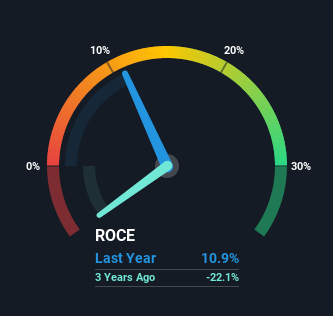- Saudi Arabia
- /
- Telecom Services and Carriers
- /
- SASE:7040
There's Been No Shortage Of Growth Recently For Etihad Atheeb Telecommunication's (TADAWUL:7040) Returns On Capital

To find a multi-bagger stock, what are the underlying trends we should look for in a business? Ideally, a business will show two trends; firstly a growing return on capital employed (ROCE) and secondly, an increasing amount of capital employed. Ultimately, this demonstrates that it's a business that is reinvesting profits at increasing rates of return. Speaking of which, we noticed some great changes in Etihad Atheeb Telecommunication's (TADAWUL:7040) returns on capital, so let's have a look.
Return On Capital Employed (ROCE): What is it?
For those that aren't sure what ROCE is, it measures the amount of pre-tax profits a company can generate from the capital employed in its business. The formula for this calculation on Etihad Atheeb Telecommunication is:
Return on Capital Employed = Earnings Before Interest and Tax (EBIT) ÷ (Total Assets - Current Liabilities)
0.11 = ر.س62m ÷ (ر.س1.0b - ر.س462m) (Based on the trailing twelve months to June 2021).
Thus, Etihad Atheeb Telecommunication has an ROCE of 11%. In absolute terms, that's a pretty normal return, and it's somewhat close to the Telecom industry average of 9.9%.
Check out our latest analysis for Etihad Atheeb Telecommunication

Historical performance is a great place to start when researching a stock so above you can see the gauge for Etihad Atheeb Telecommunication's ROCE against it's prior returns. If you want to delve into the historical earnings, revenue and cash flow of Etihad Atheeb Telecommunication, check out these free graphs here.
What Does the ROCE Trend For Etihad Atheeb Telecommunication Tell Us?
We're delighted to see that Etihad Atheeb Telecommunication is reaping rewards from its investments and has now broken into profitability. Historically the company was generating losses but as we can see from the latest figures referenced above, they're now earning 11% on their capital employed. In regards to capital employed, Etihad Atheeb Telecommunication is using 28% less capital than it was five years ago, which on the surface, can indicate that the business has become more efficient at generating these returns. Etihad Atheeb Telecommunication could be selling under-performing assets since the ROCE is improving.
On a side note, Etihad Atheeb Telecommunication's current liabilities are still rather high at 45% of total assets. This effectively means that suppliers (or short-term creditors) are funding a large portion of the business, so just be aware that this can introduce some elements of risk. While it's not necessarily a bad thing, it can be beneficial if this ratio is lower.
Our Take On Etihad Atheeb Telecommunication's ROCE
From what we've seen above, Etihad Atheeb Telecommunication has managed to increase it's returns on capital all the while reducing it's capital base. Since the stock has only returned 28% to shareholders over the last five years, the promising fundamentals may not be recognized yet by investors. So with that in mind, we think the stock deserves further research.
If you'd like to know about the risks facing Etihad Atheeb Telecommunication, we've discovered 1 warning sign that you should be aware of.
While Etihad Atheeb Telecommunication may not currently earn the highest returns, we've compiled a list of companies that currently earn more than 25% return on equity. Check out this free list here.
Valuation is complex, but we're here to simplify it.
Discover if Etihad Atheeb Telecommunication might be undervalued or overvalued with our detailed analysis, featuring fair value estimates, potential risks, dividends, insider trades, and its financial condition.
Access Free AnalysisThis article by Simply Wall St is general in nature. We provide commentary based on historical data and analyst forecasts only using an unbiased methodology and our articles are not intended to be financial advice. It does not constitute a recommendation to buy or sell any stock, and does not take account of your objectives, or your financial situation. We aim to bring you long-term focused analysis driven by fundamental data. Note that our analysis may not factor in the latest price-sensitive company announcements or qualitative material. Simply Wall St has no position in any stocks mentioned.
Have feedback on this article? Concerned about the content? Get in touch with us directly. Alternatively, email editorial-team (at) simplywallst.com.
About SASE:7040
Etihad Atheeb Telecommunication
Provides telecommunication products and services for individuals and businesses in the Kingdom of Saudi Arabia and internationally.
Excellent balance sheet and slightly overvalued.
Market Insights
Community Narratives





